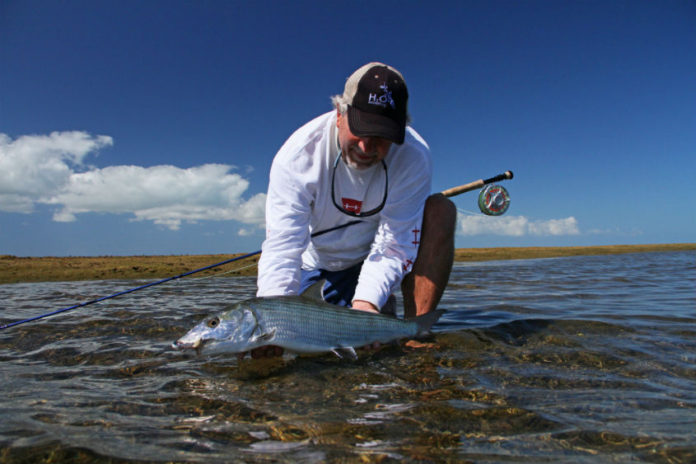Written by: Greg Vincent, H2O Bonefishing
Catching a bonefish is an accomplishment for any angler, novice or expert.
Photo courtesy H20 Bonefishing
Every year, hundreds of new anglers join the migration to the tropics in search of what many consider to be one of the world’s finest light-tackle game fish: bonefish. Here in The Bahamas, we are fortunate to have hundreds of thousands of acres of prime habitat that supports large populations of bonefish, along with enough habitat diversity to produce a decent number of trophy-size fish. Catch and release is now the norm, which will ensure that this wonderful game fish is here to stay. Although our numbers and size are impressive, those new to fly fishing shouldn’t expect to just show up and have these fish to jump in the boat and start rummaging in your tackle bag for a fly to eat. The gray ghost is hard to see and at times even harder to catch. They were designed that way, and it’s the main reason why this type of angling can be classed as a true sport.

First-time anglers should be ready to learn a lot, even when they aren’t casting.
Photo by Sandy Hays
As with any first-time attempt at something new, it can often be difficult to effectively apply your existing freshwater skills to the new task at hand. Combine the new alien environment and technique with generally short outings of three to six days of fishing, and anglers often need several years of experience before they feel confident in their ability to present a fly in any type of situation. It’s almost impossible to successfully teach the required casting techniques in the adrenaline-charged conditions immediately before presentation. This leads to compromising shortcuts in the hope of producing a few extra fish. This instant-gratification process is the slippery slope in creating the proverbial “old dog, new tricks” angler whose learning curve levels out well before reaching its potential. Even after the fly is in the water, the angler is faced with series of completely unfamiliar requirements—dealing with fly animation and bite detection—that need to be executed in a matter of a few seconds. This can all add up to disappointment, and newcomers are often dealt a hard and unsympathetic blow from Mr. Reality.
However, it’s a mistake to think that fly fishing for bonefish is only for experts. As long as newcomers don’t arrive in the tropics with overblown expectations—and they approach the need to learn new skills enthusiastically—even a difficult trip can be incredibly rewarding. A novice saltwater fly fisher should arrive on our shores ready to start an educational journey and to fall in love with a new sport. If you arrive expecting that you’ll be bending into bonefish every few minutes of the day, you’re setting yourself up for disappointment.

Each bonefish that comes to hand is a learning experience.
Photo courtesy H20 Bonefishing
New bonefishers often arrive believing that successful bonefishing is almost exclusively about the cast. They think that all you have to do is get the fly in the zone and the fish will eat it. This is not the case as the zone changes depending on things like water depth, the fish’s speed, wave action or lack of it, and fly sink rate. A fish caught on an exposed deeper flat edge needs a completely different approach than one that, although on the same flat, is on the inside in flat calm and shallow water. Fly presentation is a far more hurried affair from the front of a moving skiff than most anglers are used to in their normal fly-fishing environment, and assuming that the fly has been presented in the correct position, then the subtleties of fly animation and bite detection are what often turns an ordinary day into an exceptional one. Each bonefish’s reaction to the fly is different, and anglers can only begin to notice and understand these subtle changes after they have worked through the “panic presentations” of their first few days on the water. Achieving success by throwing a fly at a school of 200 1- to 2-pound fish in three feet of water doesn’t require the same skill as a successful presentation at a pair of “snarfling,” tailing 10-pound fish in 10 inches of water. However, it may only take one of the latter fish to make any angler’s trip.

Fly-fishing for bonefish is a great way to hone all your angling skills.
Photo by Sandy Hays
Creating a relaxed yet very informative atmosphere for learning puts far less pressure on the novice fly fisherman, as well as the guide. The angler’s acclimation to their newfound surroundings becomes easier, which will make him or her more confident and ultimately competent. Those hectic moments after a fish has been spotted are not the best time to learn anything, except in hindsight. Every time a fish is spotted is a learning experience, but the angler with a calmer approach and less expectation will almost always come away with more and enjoy the moment, regardless of the outcome.
Bonefishing is not simply a catching exercise, and every angler needs to value and appreciate the time on the flats, the stalk, and the excitement of spotting fish as much as they appreciate a fish brought to hand. Without all these other aspects of the sport, this magnificent game fish would not deserve the respect that makes it such a special quarry to both novice and expert alike.
Greg Vincent operates of H2O Bonefishing on Grand Bahama Island.
Credit: Source link






























